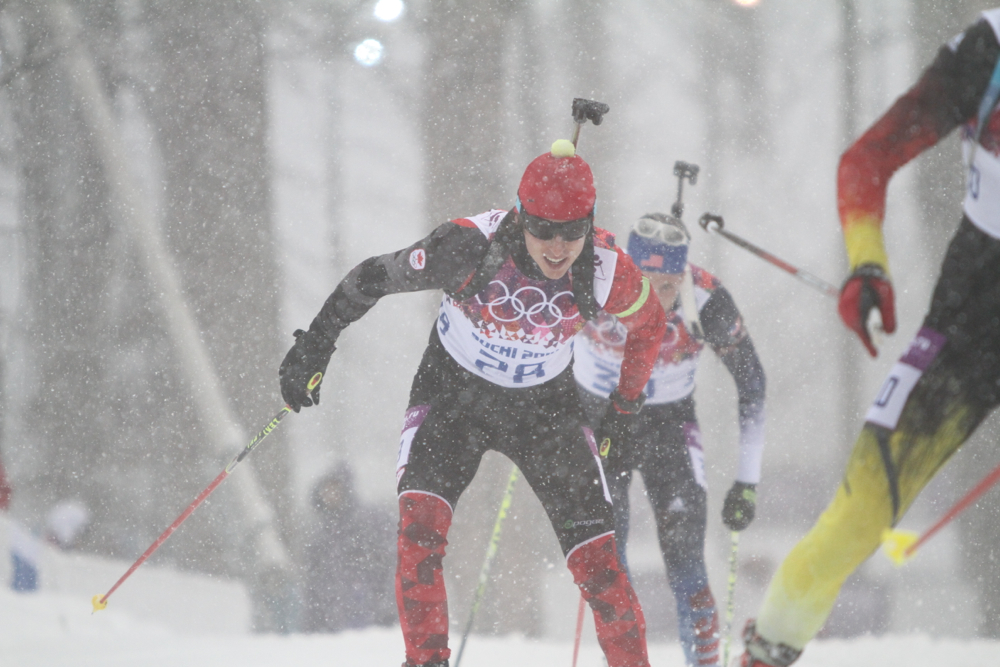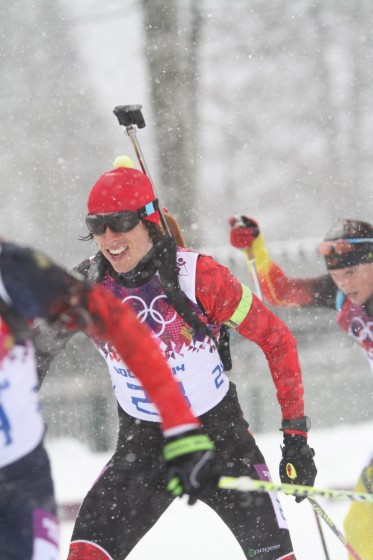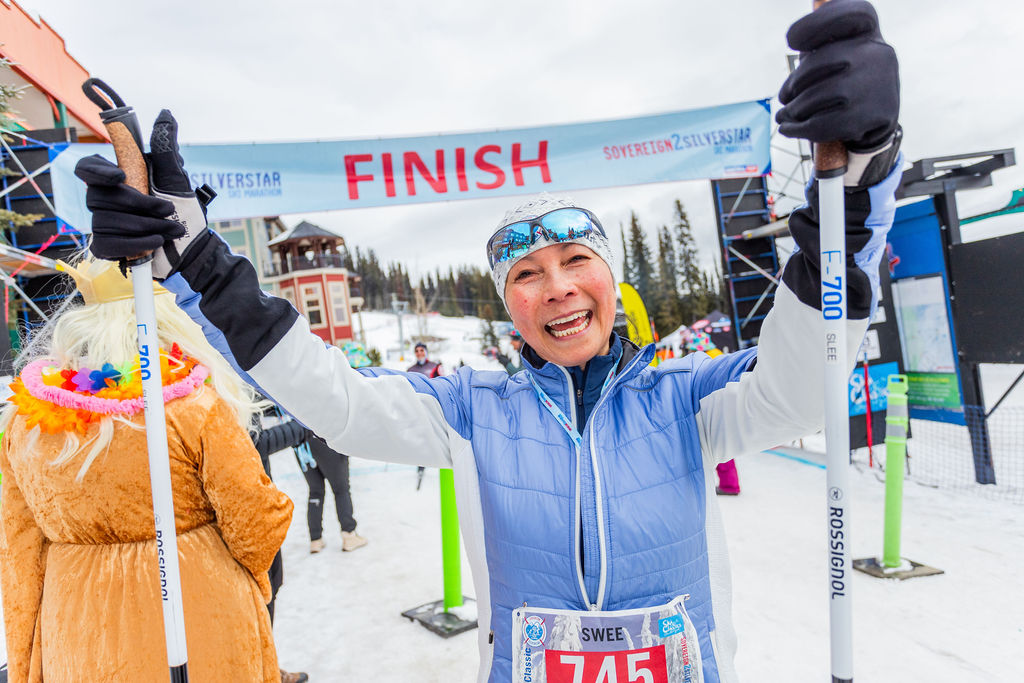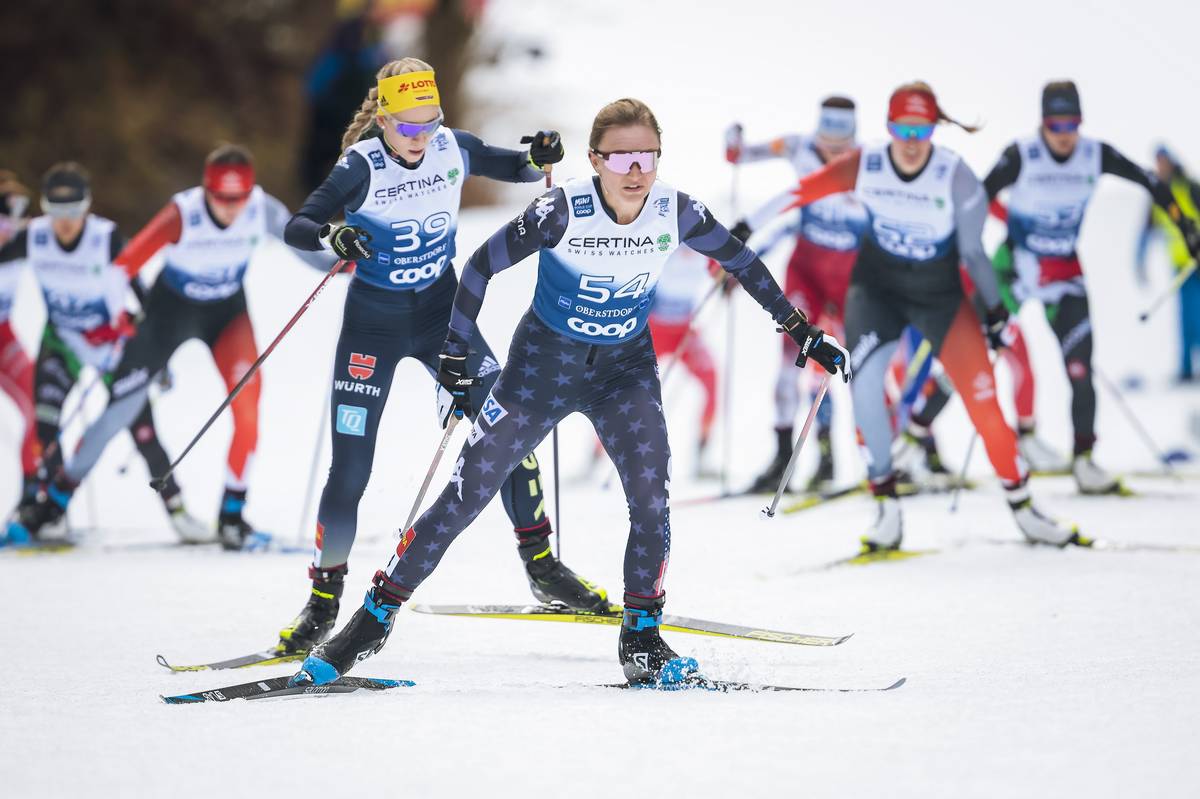
FasterSkier’s coverage is made possible through the generous support of Swix.
KRASNAYA POLYANA, Russia – When three Canadian went to the start line of today’s 15 k mass start, they were already doing something big. Never before had so many Canadian men qualified for the format, which is limited to 30 racers, and definitely not at the Olympics.
Like much that has happened to the Canadian team this week – Jean Philippe Le Guellec’s crash that broke a ski while he was leading the Olympic pursuit comes to mind – things didn’t work out perfectly. In a strange version of déjà vu, teammate Nathan Smith got tangled up with two other racers and crashed, also ripping a binding off his ski just as Le Guellec had.
Neither Smith nor Simon Fourcade of France, also in the crash, finished the race. So while Canada may have started three men, they only finished two.
But what a pair it was: Brendan Green passed Le Guellec on the final loop to finish ninth, while Le Guellec placed tenth (stay tuned for a separate story on Le Guellec later).
“I think for the men, this is the best result [ever at the Olympics],” said Biathlon Canada Head Coach Matthias Ahrens. “I’m pretty sure.”
It was particularly gratifying because it was the last individual race at the international level for Le Guellec, who is retiring at the end of this season. To finish in the top ten, along with a teammate, was one the best ways he could end – besides a medal, of course.
“This is JP’s last hurrah, his last individual race,” Green said, adding that he gave Le Guellec a “big hug” in the finish pen. “So to finish in the top ten together, that’s special. And he has been a great role model for me, an inspiration. I’ve learned a lot from him over the years. It’s a nice way for him to go out.”
The Canadian men have showed potential for top finishes throughout the Games so far. In the opening race, a sprint, Le Guellec placed fifth and Smith 13th. In the pursuit, Smith moved up to 11th. They knew, they said, that there was the opportunity to place several men in the top ten – or even better.
“For sure that was our hope,” said Le Guellec’s coach, Jean Paquet. “Once we got in and we saw that we had one in the top five, and the other guys were skiing very well, well enough to finish in the top ten, yes, we were confident.”

Today, though? Maybe not. After having this race delayed for two days straight due to heavy fog that obscured the targets, the men woke up to see snow falling outside – heavy, wet snow. That didn’t make anyone particularly excited. Le Guellec later described them as “nightmare conditions” that don’t suit his technique.
“After the races last week I knew my form was good,” Green said. “I knew the potential was there to have a better race. To be honest, I didn’t think it would come today with these conditions. I usually have a really tough time when the snow is deep and slushy, and that sort of thing. Usually this isn’t my game.”
Yet he soon found himself right in the thick of things. Despite starting in bib 28, in the very last row of the mass start, and getting pinched in the first corner, Green started moving up.
“Just the way the trains worked out, I was able to get in the mid pack early on,” he said. “There was a crash on the first downhill that took out Nathan. I was able to get around that okay. So I just tried to slowly work my way through.”
With a penalty in each of the first two stages, Green was hovering around 20th. But he cleaned each of his standing stages to move into 17th, then 11th, and finally skied the sixth-fastest last loop to pass Le Guellec and Anton Shipulin of Russia, securing ninth place and the second-best international result of his career.
Yet for Canada, there is a distinct sense of what might have happened. Just as in the pursuit, Le Guellec was skiing in the top six for a large chunk of the race. He was derailed by a penalty, but also by getting snow stuck in his rifle sight during the third stage, which required some work and gave him a 45-second shooting stage. Fast shooting is usually Le Guellec’s key to success. One stage earlier he had come in with a large pack, and cleaned his targets faster than anyone to move into second place.
“It’s always a mixed feeling because they knew they were good, but they also knew they were close,” Paquet, a former athlete himself, said of Le Guellec and Green. “So they are disappointed about the small mistakes they did, like missing one shot too many. That’s what they are disappointed about. It’s a mixed feeling because they are so close, and they know they were right there.”
Biathlon Canada is in serious need of medals, as its funding from Own the Podium is contingent on performance. Today was yet another might-have-been day.

“I knew that we needed clean shooting,” Paquet said. “When I heard Brendan missing one and one, no. And I knew JP needed to be clean all four stages, and nice and fast. He had a shooting time of 45 seconds. We knew it needed to be a perfect race. It wasn’t there completely. Top ten is great, but we knew what we needed to have to finish even better.”
But everyone involved was able to look at the positives of the men’s strong races.
“Brendan’s performance today was just outstanding,” Biathlon Canada High Performance Director Chris Lindsay said after the race. “His ski speed was fantastic, especially for him with his history of weakness this season in standing shooting in the later part of the races. Seeing him be able to really tighten it up at the end was a clear indicator that the whole team is ready and set for the relay.”
(Le Guellec and Smith have opted to sit out the mixed relay and rest up the men’s relay, which will be a priority race for Canada. After a time trial among the women today, Canada has selected Megan Imrie and Rosanna Crawford to team up with Green and Scott Perras in tomorrow’s mixed relay.)
With Le Guellec retiring at the end of this season, it was particularly gratifying for the Canadians to see Green’s performance. He spent almost a year and a half recovering from a serious back injury, but has proved himself on the biggest stage in biathlon. That makes it easier for Green to guess that he’ll stay in the sport a few more years.
“This season I had a lot of question marks with the back, and how the body would respond and feel, and that sort of thing,” Green said. “But I seem to be back in my old form and racing well. And when you’re racing well it’s a lot of fun. There’s a World Cup in Canmore in 2016. So I think if I’m healthy I’d like to race that, and bring my career full circle and probably end there.”
And even though Smith didn’t finish the race, the very fact that he made it into the mass start in his first Olympics was a positive sign for Canada’s development pipeline. Smith had never made the top 30 in a World Cup race before this season, but had racked up seven such results before the Olympics even began. From the outside he would not have been a good pick to finish twice in the top 15 in this year’s Games.
“We were not worried about Nathan’s performance at the end of last year, even though it was not on par compared to the season before with his three wins on the IBU Cup,” Lindsay said. “But everyone’s allowed to have an off year. We look forward to him being one of the role models and leaders for the next two years.”
In fact, Lindsay said, having a mix of performances at this Olympics both from veterans like Green and Le Guellec and from newcomers like Smith is a strong advertisement for the federation’s development strategy.
“It shows that the program is working, and that we need to continue putting efforts in the same way that we have been and not radically change what we’re doing,” Lindsay said. “The approach with one unified training center, a lot of focus in what the coaches are doing, and a lot of control given to those coaches, is what’s getting us the results. The longer we do this, the more results we’ll get.”
Regardless of how the team got to where it is, Green is just happy to be part of a best-ever day.
“We made some history today I guess,” Green said. “It’s so awesome. It’s a sign that we are strong and have some depth. And hopefully our future is bright.”
Chelsea Little
Chelsea Little is FasterSkier's Editor-At-Large. A former racer at Ford Sayre, Dartmouth College and the Craftsbury Green Racing Project, she is a PhD candidate in aquatic ecology in the @Altermatt_lab at Eawag, the Swiss Federal Institute of Aquatic Science and Technology in Zurich, Switzerland. You can follow her on twitter @ChelskiLittle.



